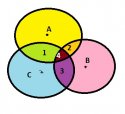I thought it might help to have a visual of triangulation (sorry if someone has already included one), just to help show what it can, and what it can't do in a case like this.
For triangulation to work, there has to be a minimum of 3 towers close enough for the phone to ping. In the diagram I've included there are 3 towers: A, B & C (although I believe there is only one usable tower near Vallecito). If a call pings only A, it is located somewhere in the yellow section; if it pings only B, it is somewhere in the pink section; if it pings only C, it is somewhere in the blue section.
If it pings both A & B, it is somewhere in the orange section (section 2); if it pings both A & C, it is somewhere in the green section (section 1); if it pings both B & C, it is somewhere in the purple section (section 3); if it pings all 3 towers, it is located in the brownish section (section 4).
If any of the towers have directional antennae, it will help narrow it down a bit more. For instance, if a ping hits a NE facing antenna on Tower C, but doesn't hit either of the other towers, the phone is most likely in the small section NE of the tower (black dot), south of section 1 and west of section 3. Depending on the amount of overlap, it could be a fairly large area, or a much smaller one.
I hope this helps a little bit.
For triangulation to work, there has to be a minimum of 3 towers close enough for the phone to ping. In the diagram I've included there are 3 towers: A, B & C (although I believe there is only one usable tower near Vallecito). If a call pings only A, it is located somewhere in the yellow section; if it pings only B, it is somewhere in the pink section; if it pings only C, it is somewhere in the blue section.
If it pings both A & B, it is somewhere in the orange section (section 2); if it pings both A & C, it is somewhere in the green section (section 1); if it pings both B & C, it is somewhere in the purple section (section 3); if it pings all 3 towers, it is located in the brownish section (section 4).
If any of the towers have directional antennae, it will help narrow it down a bit more. For instance, if a ping hits a NE facing antenna on Tower C, but doesn't hit either of the other towers, the phone is most likely in the small section NE of the tower (black dot), south of section 1 and west of section 3. Depending on the amount of overlap, it could be a fairly large area, or a much smaller one.
I hope this helps a little bit.

